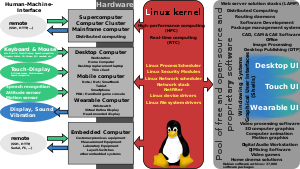Talk:Controversy over GNOME 3
| This is the talk page for discussing improvements to the Controversy over GNOME 3 redirect. This is not a forum for general discussion of the article's subject. |
Article policies
|
| Find sources: Google (books · news · scholar · free images · WP refs) · FENS · JSTOR · TWL |
| Archives: 1Auto-archiving period: 1200 days |
| This redirect does not require a rating on Wikipedia's content assessment scale. It is of interest to the following WikiProjects: | ||||||||||||||
| ||||||||||||||
Baby Duck Syndrome[edit]
I don't think this link is really wrong here. The target discusses the closely related issue. — Dmitrij D. Czarkoff (talk) 22:07, 8 January 2012 (UTC)
Link to Baby duck syndrome[edit]
I've removed the link again. I would consider it a POV, because it's debatable whether people reject GNOME 3 because they are used to traditional desktops, or because it is actually less usable. I can't say objectively which is better (after all it's different for everyone) but I don't think Wikipedia should be choosing a side by including that link, thereby suggesting that people who don't like GNOME 3 are just stuck in their traditional way of working. CodeCat (talk) 17:03, 13 June 2012 (UTC)
Request deletion[edit]
There's nothing of value on this page except a few people freaking out over change and a few scattered opinions. It's existence seems like more of an attempt to slander the competition than anything. Even Linus Torvalds has since gone back to using GNOME ("with some extensions").
Sure, there was some controversy, but this page is hollow and utterly uninteresting. There's no Wikipedia articles for "controversy over Ubuntu Unity" or "controversy over Windows 8", despite both of them receiving an equal or greater amount of negative reception.
Request this flimsy article be deleted or (partially) merged into the GNOME article. — Preceding unsigned comment added by 86.129.240.245 (talk) 10:07, 24 November 2012 (UTC)
- This is the first link (after the official page) that comes up in a Google search for "gnome 3". Since it doesn't have any real content (except some statements from Linus. Linus, himself, has described people quoting his opinions on such things as "silly". Deleting this page would bring users searching for "gnome 3" to the actual GNOME wiki page, which is of much higher quality. Jefftaylor42 (talk) 23:19, 21 April 2014 (UTC)
dropping the fallback mode ?[edit]
IIRC there was a press release on LWN recently, confirming that GNOME have explicitly said they are dropping the fallback mode completely. This should be mentioned in the fallback section of the article. (I'd do it myself but ICBF digging up the reference.) 02:34, 21 November 2012 (UTC) — Preceding unsigned comment added by 203.7.155.73 (talk)
- This has been mentioned. Fallback development has resumed under the name Flashback and this has likewise been mentioned. -- Charlesb95 (talk) 10:49, 24 April 2014 (UTC)
Merge this article into GNOME?[edit]
This article was initially created as a staging area for an ongoing (back then) controvercy over GNOME 3 release. Now, that the issue settled down, I propose to merge the material back into GNOME § GNOME 3. Of course this article has to be compressedand in order to balance its weight after merger. — Dmitrij D. Czarkoff (talk•track) 00:00, 22 April 2014 (UTC)
- Usability of GNOME 3 aside, most of the opinions are about GNOME 3.2 or GNOME 3.4. The Shell has changed significantly since then, perhaps to the point where those opinions are no longer valid. I think the stuff about Fallback/Flashback is better addressed on the GNOME Panel page, perhaps with a note on the GNOME page redirecting those interested about Fallback/Flashback to the page. The stuff about MATE and Cinnamon is already mentioned on the GNOME page. So personally, I don't think very much of this needs to preserved. -- Charlesb95 (talk) 10:48, 24 April 2014 (UTC)
- Then this all page may be simply redirected to GNOME § GNOME 3? Probably, a note that several first releases were not well-recieved and a cluster of refs could be added right before the sentence about MGSE. — Dmitrij D. Czarkoff (talk•track) 12:51, 24 April 2014 (UTC)
- Sounds reasonable to me. -- Charlesb95 (talk) 13:20, 25 April 2014 (UTC)
- So done. Sandstein 17:29, 7 December 2014 (UTC)
- Sounds reasonable to me. -- Charlesb95 (talk) 13:20, 25 April 2014 (UTC)
- Then this all page may be simply redirected to GNOME § GNOME 3? Probably, a note that several first releases were not well-recieved and a cluster of refs could be added right before the sentence about MGSE. — Dmitrij D. Czarkoff (talk•track) 12:51, 24 April 2014 (UTC)
GNOME GUI or GNOME Shell[edit]
After reading the article it is not clear to me, whether the controversy is about the GNOME Shell or the GNOME GUI, i.e. the GUI widgets in GTK+ (some where deprecated, some deleted and a couple of new ones have been added. Fact is, that while KDE Plasma provides multiple UXes for the different screen sizes and input methods, GNOME Shell targets them all. User:ScotXWt@lk 19:25, 8 June 2014 (UTC)

- Really? Try reading once again – article unambiguously answers your question. P.S.: Could you please stop pushing this picture? — Dmitrij D. Czarkoff (talk•track) 19:47, 8 June 2014 (UTC)
- What concrete argument do you have against this picture being in the GNOME Shell article? User:ScotXWt@lk 20:58, 10 June 2014 (UTC)
- Please, see Talk:GNOME Shell § Diagrams. — Dmitrij D. Czarkoff (talk•track) 23:59, 10 June 2014 (UTC)
- What concrete argument do you have against this picture being in the GNOME Shell article? User:ScotXWt@lk 20:58, 10 June 2014 (UTC)
- Redirect-Class Computing articles
- NA-importance Computing articles
- Redirect-Class software articles
- NA-importance software articles
- All Software articles
- Redirect-Class Free and open-source software articles
- NA-importance Free and open-source software articles
- All Free and open-source software articles
- All Computing articles



